


Updated February 2021
D2 0-4-2 No 308 ‘Como’
This engine has had a very long gestation period - one of those projects which stalls for some reason, put on a shelf and forgotten about for a couple of years. I can’t remember now exactly why or when I stopped work on it, but it must be at least five years ago - certainly before I started work on Plumpton. However, I have decided that this year (2016) will be my ‘year of the loco’ - a push to get all existing locos working properly, and to finish a number of other engines which have been started but not finished.
The D2 0-4-2 tender engines are well proportioned in the Stroudley style, being closely modelled on the D1 0-4-2 tanks. The motion is identical, but a slightly larger boiler has been substituted, to provide a better supply of steam for express workings. They were built primarily for fast perishables workings from the Worthing area and Newhaven harbour, so ideally suited for Plumpton Green (being on the route from London to Newhaven). They were also used on the occasional passenger service.
Perhaps their main claim to fame is that they were the forerunners of the Richmond class, and ultimately the Gladstone class - both 0-4-2 tender engines, but with 6’6” drivers and larger boilers. All of the D2’s (also known as the ‘Lyons’ class) were named for European cities.

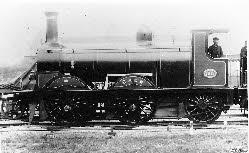 Como (no 308) was built in 1883, as part of the second batch, differing slightly from the first eight of the class, with the most noticeable differences being the cast-
Como (no 308) was built in 1883, as part of the second batch, differing slightly from the first eight of the class, with the most noticeable differences being the cast-iron brake-shoes with clasp brakes, and the reversing rod outside the firebox casing (compare photos left and right). Como was withdrawn in 1904, after a seemingly uneventful life, but having travelled an impressive 688,000 miles.
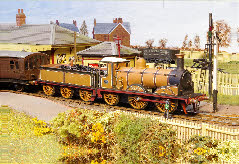
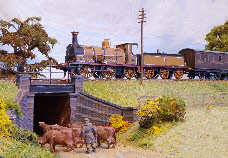 My model is a scratchbuilt effort in nickel-
My model is a scratchbuilt effort in nickel-silver, with hand-drawn transfers applied for the lining. The photos show the engine on a trial run on Plumpton, in a nearly complete state, with a little more detailing required - including sanding gear and pesky clasp brakes.
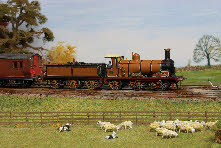
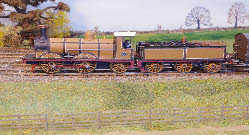 When I first painted this engine, I varnished it with Humbrol water based varnish, and the finish was not very satisfactory. The yellow ochre was very flat and washed out, with no depth of colour at all. After a couple of years of wondering what to do with it, I took a gamble, and over-
When I first painted this engine, I varnished it with Humbrol water based varnish, and the finish was not very satisfactory. The yellow ochre was very flat and washed out, with no depth of colour at all. After a couple of years of wondering what to do with it, I took a gamble, and over-sprayed it with a spirit based varnish.
I’ve not had a lot of success with Humbrol varnishes since they changed their recipe. I was recommended Ronseal hardglaze as an alternative. I sprayed it first with a couple of coats of gloss varnish, and then a couple of coats of gloss with a little matting agent added to give a nice deep satin finish. The photo on the left shows the Humbrol acrylic finish, and the photo on the right shows the loco, now finished with clasp brakes and sanding gear, after the respray. (Don’t be tempted to use the Ronseal satin varnish - it gives a horrible pimply finish which cannot be rectified).
D2 0-
This engine has had a very long gestation period -
The D2 0-
Perhaps their main claim to fame is that they were the forerunners of the Richmond class, and ultimately the Gladstone class -

 Como (no 308) was built in 1883, as part of the second batch, differing slightly from the first eight of the class, with the most noticeable differences being the cast-
Como (no 308) was built in 1883, as part of the second batch, differing slightly from the first eight of the class, with the most noticeable differences being the cast-
 My model is a scratchbuilt effort in nickel-
My model is a scratchbuilt effort in nickel-
 When I first painted this engine, I varnished it with Humbrol water based varnish, and the finish was not very satisfactory. The yellow ochre was very flat and washed out, with no depth of colour at all. After a couple of years of wondering what to do with it, I took a gamble, and over-
When I first painted this engine, I varnished it with Humbrol water based varnish, and the finish was not very satisfactory. The yellow ochre was very flat and washed out, with no depth of colour at all. After a couple of years of wondering what to do with it, I took a gamble, and over-I’ve not had a lot of success with Humbrol varnishes since they changed their recipe. I was recommended Ronseal hardglaze as an alternative. I sprayed it first with a couple of coats of gloss varnish, and then a couple of coats of gloss with a little matting agent added to give a nice deep satin finish. The photo on the left shows the Humbrol acrylic finish, and the photo on the right shows the loco, now finished with clasp brakes and sanding gear, after the respray. (Don’t be tempted to use the Ronseal satin varnish -